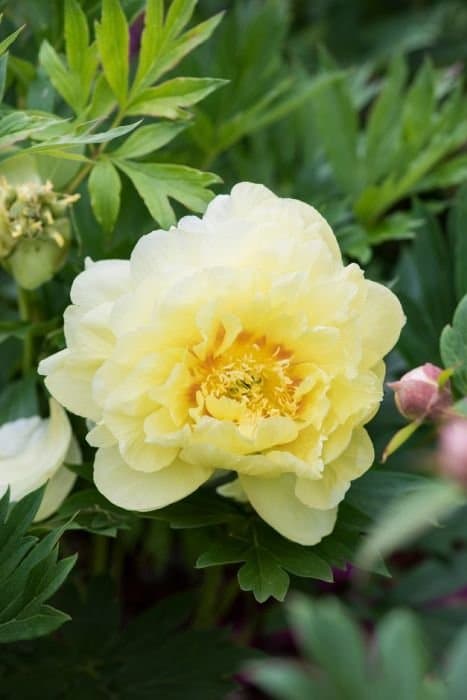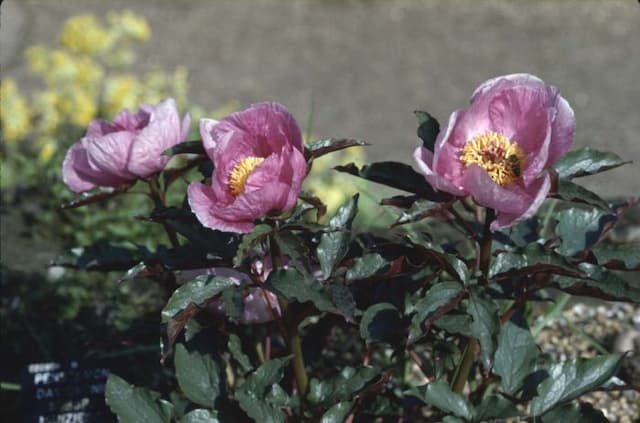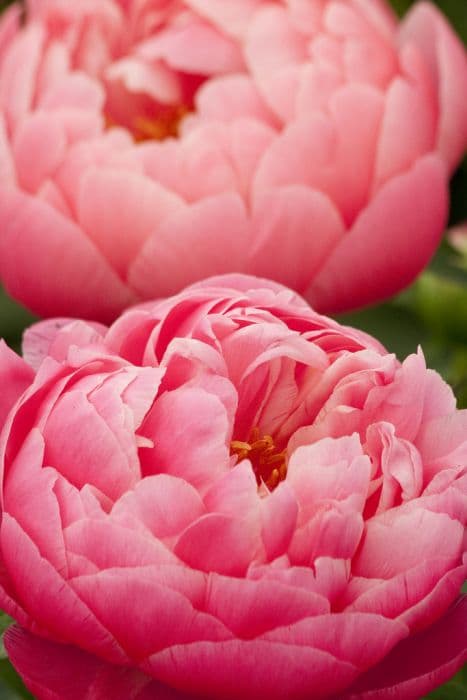Rock's Peony Paeonia rockii (S)

ABOUT
Paeonia rockii, known commonly as Rock's peony, is a deciduous shrub with a striking appearance. Its notable features include large, white flowers that boast a prominent deep purple or maroon basal blotch at the base of each petal. These fragrant blossoms have a fluffy, full look, with several layers of petals circling a center packed with contrasting yellow stamens, giving them a lush, opulent feel. The petals themselves range from pure white to a soft, creamy hue, adding to the elegance of the bloom. The leaves of Rock's peony are equally attractive, with a deep green color and a glossy surface. They are divided into leaflets, which have an oval to lance-shaped appearance and elegant, smooth edges. In the growing season, the foliage creates a lush backdrop for the spectacular flowers. Rock's peony also produces attractive seed pods after the flowering season, which gives it additional interest in a garden setting even when it is not in bloom. The pods split open to reveal seeds that are embedded in a fleshy, blue-black coating. These seed pods add a textural dimension to the plant as it progresses through the seasons. Overall, Rock's peony has a robust and bushy appearance, with a dense collection of stems that give it a rich and full aesthetic. Its stunning flowers, lovely foliage, and interesting seed pods make Rock's peony a favorite among garden enthusiasts who seek to add a dramatic and fragrant statement to their landscapes.
About this plant
 Names
NamesSynonyms
Rock's Peony, Tree Peony
Common names
Paeonia suffruticosa subsp. rockii, Paeonia rockii var. rockii.
 Toxicity
ToxicityTo humans
Tree peony is not known to be toxic to humans; however, as with any plant not typically used for consumption, it's possible for some individuals to have allergic reactions or mild gastrointestinal symptoms if eaten. There are no widely recognized severe toxic effects from ingesting tree peony for humans.
To pets
Tree peony is generally considered to have low toxicity to pets. If ingested, it may cause mild gastrointestinal upset, including vomiting or diarrhea. However, there are no severe toxic effects commonly associated with tree peony ingestion for pets such as cats and dogs. It is always best to prevent pets from eating ornamental plants as individual sensitivities can vary.
 Characteristics
CharacteristicsLife cycle
Perennials
Foliage type
Deciduous
Color of leaves
Green
Flower color
White
Height
3-4 feet (0.9-1.2 meters)
Spread
3 feet (0.9 meters)
Plant type
Shrub
Hardiness zones
3-8
Native area
China
Benefits
 General Benefits
General Benefits- Aesthetic Appeal: Rock's peony adds visual interest to gardens with its large, fragrant white flowers that have a distinctive maroon basal blotch.
- Attracts Pollinators: The flowers are attractive to bees, butterflies, and other pollinating insects, thereby supporting local ecosystems.
- Cultural Significance: Rock's peony has a rich history in Chinese art and culture and is considered a symbol of wealth and nobility.
- Landscape Uses: Can be used as a specimen plant, in mixed borders, or in herbaceous borders, providing structure to garden design.
- Durability: Once established, Rock's peony is relatively drought tolerant, requiring minimal maintenance and watering.
- Longevity: Rock's peony is a perennial plant that can live for many years, even decades, making it a long-term addition to the garden.
- Cut Flowers: The blooms make excellent cut flowers, adding elegance and fragrance to floral arrangements.
 Medical Properties
Medical Properties- Anti-inflammatory: Paeonia rockii has been used to reduce inflammation in traditional medicine practices.
- Analgesic: The plant may have pain-relieving effects.
- Antioxidant: Contains compounds that exhibit antioxidant properties, potentially reducing oxidative stress.
- Immunomodulatory: Might have effects on modulating the immune system.
- Antitumor: Some studies suggest potential antitumor activity in certain compounds found in the plant.
- Hepatoprotective: Could offer some protection to the liver from toxic substances.
 Air-purifying Qualities
Air-purifying QualitiesThis plant is not specifically known for air purifying qualities.
 Other Uses
Other Uses- Cut Flower Arrangements: The large, showy blooms of the Paeonia rockii make it a popular choice for cut flower arrangements and floral designs.
- Ornamental Gardening: Due to its striking appearance and pleasant fragrance, this plant is commonly used as a focal point in ornamental gardens.
- Skin Care Products: The petals of Paeonia rockii are sometimes incorporated into lotions and potions for their fragrance and potential skin-soothing properties (excluding any effects that would be considered medical).
- Artistic Inspiration: The beauty of Paeonia rockii has inspired many artists to feature it in paintings, drawings, and even fabric designs.
- Wedding Decor: Because of its association with romance and prosperity, the Paeonia rockii is often used in wedding bouquets and décor.
- Natural Dye: The pigments in the petals can be used to create a natural dye for fabrics or paper.
- Photography: The plant's stunning flowers make it a sought-after subject for photographers, particularly in spring when it is in bloom.
- Garden Borders: Paeonia rockii is used to create dramatic borders in garden landscaping, offering a contrast to green foliage with its vivid flowers.
- Scented Gardens: The plant adds a rich, sweet fragrance to scented gardens and outdoor living spaces.
- Culinary Garnish: Although not a common use and only when it's certain the plant is free of pesticides and other chemicals, the petals of Paeonia rockii could be used as a decorative garnish for elegant desserts and dishes.
Interesting Facts
 Feng Shui
Feng ShuiThe Rockii peony is not used in Feng Shui practice.
 Zodiac Sign Compitability
Zodiac Sign CompitabilityThe Rockii peony is not used in astrology practice.
 Plant Symbolism
Plant Symbolism- Prosperity: Paeonia rockii, commonly known as Rock's peony, is often associated with wealth and good fortune, making it a popular plant in gardens that are meant to attract prosperity.
- Romance: As with many peonies, Rock's peony represents romance and romantic love, perhaps due to its lush, full blooms and rich fragrance that have traditionally been linked with love and affection.
- Honor and High Social Status: In certain cultures, particularly in China where the plant has a long history, Rock's peony is seen as a symbol of honor and high social status, likely because of its use in imperial gardens and its relatively rare and sought-after status.
- Female Beauty: The opulent and showy flowers of Rock's peony are reminiscent of feminine beauty, making it a symbol often associated with the ideal of female form and allure.
- Healing: Historically, peonies including Rock's peony have been used in traditional medicine. Therefore, they are connected to the symbolism of healing and are thought to bring good health.
- Compassion: The soft and delicate appearance of the flower is sometimes linked with qualities of compassion and tenderness, reflecting a gentle beauty that’s both seen and felt.
 Water
WaterRock's peony should be watered once a week, providing about 1 inch of water each time to ensure the soil remains evenly moist but not waterlogged. During the growing season, in the absence of rainfall, additional watering may be necessary. However, it is crucial to avoid overhead watering to prevent fungal diseases; instead, water at the base of the plant. During the winter or dormant period, watering should be reduced to prevent root rot, especially if the soil does not dry out between watering sessions. Typically, this will mean watering every two to three weeks, or even less, depending on the climate and soil drainage.
 Light
LightRock's peony thrives best in full sun to partial shade conditions, with at least six hours of sunlight per day. Ideally, plant it in a spot that receives morning light and is protected from the intense afternoon sun, especially in hotter climates. This balance encourages vibrant blooms while minimizing the stress on the plant from excessive heat.
 Temperature
TemperatureRock's peony is hardy and can tolerate a wide range of temperatures but grows best when daytime temperatures are between 65°F and 75°F. It can survive winter cold down to -20°F, making it suitable for many temperate climates. During active growth and blooming periods, consistently moderate temperatures will yield the best flowering results.
 Pruning
PruningPrune Rock's peony in the fall, after the leaves have died back, to remove any spent flowers and dead foliage, which helps to prevent disease. Additionally, every few years, cut back the plant to rejuvenate it and promote healthy growth. The best time for pruning is after the first frost has occurred but before the ground freezes.
 Cleaning
CleaningAs needed
 Soil
SoilThe Rockii Tree Peony prefers a well-draining soil mix with a slightly alkaline pH between 7.0 and 8.0. A good recipe for the soil mix would be one part garden soil, one part compost, and one part perlite or coarse sand to ensure proper drainage. Mulching is beneficial to maintain moisture balance and provide nutrients.
 Repotting
RepottingRockii Tree Peonies are long-lived perennials and do not need frequent repotting. They may only need to be repotted every 3 to 5 years or when the plant outgrows its container. However, they prefer to be left undisturbed, so repotting should be done cautiously and only when necessary.
 Humidity & Misting
Humidity & MistingRockii Tree Peony does not require high humidity and is quite adaptable to the average outdoor humidity levels. It thrives well in environments with normal air moisture and does not need any special humidity adjustments for optimal growth.
 Suitable locations
Suitable locationsIndoor
Provide bright light, cool temps, and avoid wet soil.
Outdoor
Plant in full sun to part shade, in fertile, well-drained soil.
Hardiness zone
3-8 USDA
 Life cycle
Life cycleThe Rock's peony (Paeonia rockii) begins its life cycle with seed germination, which may require stratification to mimic winter conditions before it can sprout in spring. The plant then enters a vegetative stage, developing a set of true leaves on a stem and establishing a strong root system. Over several years, it matures into a larger perennial shrub with woody stems and compound, deep green leaves that dies back to the ground each winter. It reaches reproductive maturity and starts to produce distinctive large, fragrant white flowers with a purplish-black basal blotch that bloom in late spring to early summer. After pollination, usually by insects, the flowers develop into follicles containing seeds, which are then dispersed for germination to continue the life cycle. The Rock's peony may live for several decades, flowering annually once it has reached maturity.
 Propogation
PropogationPropogation time
Spring
Paeonia rockii, commonly known as the Rock's peony, is typically propagated by division, which is the most popular method. This process is best done in the autumn after the plant has gone dormant, to give the newly divided plants time to establish roots before the onset of winter. During division, the root clump is carefully dug up and excess soil is removed. The clump is then cut into sections, ensuring that each section contains at least three to five eyes, which are the growth nodes from which new stems will emerge. These sections are planted in well-drained soil at a depth where the eyes are about 1 to 2 inches (approximately 2.5 to 5 centimeters) below the soil surface. Adequate space should be provided between the divisions to allow for mature growth. This method stimulates rejuvenation of the plant and can produce flowering plants in a couple of years.









